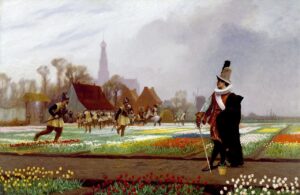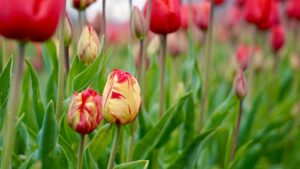As a tulip farmer at Tulip Valley Farms in the stunning Skagit Valley, I’m here to tell you why our beloved blooms are actually winter’s biggest fans! These mountain-born beauties have a fascinating relationship with the cold that’s essential to creating the spectacular display we’re famous for. Here’s a bit about where tulips come from in nature and culturally:
Tulips in the Wild
While the tulip is generally associated with Holland, the flower is not a native to this country. The tulip’s most important habitat is central Asia, or, more specifically, the northern foothills of the Himalaya Mountains. It is from here that no less than 60% of all wild tulips originate.
Experts today recognize some 100 different wild tulip species. The numbers on the map point to the regions where wild tulips can still be found today.
The Sultan’s Garden

The first tulip fanatics were the sultans of the Ottoman Empire, which at its zenith in the 16th and 17th centuries, stretched from the Caucasus to Morocco.
In their lavish palaces along the Bosporus in Istanbul, the sultans collected and displayed large quantities of tulips.
Efforts to obtain new tulips from wild forms started during the reign of Suleyman the Magnificent. Almond shaped ‘needle tulips’ were favorite and they feature prominently as decorative motifs in manuscripts and on tiles and pottery of the period.
Tulips and Holland
The tulip reached Holland around 1600. Dutch trade flourished and Holland was one of the richest countries in Europe. From the start, tulips were popular among the well-to-do.
The flower caused amazement because of her variations in color and shape. People tried to outdo each other in collecting the most unusual forms.
No wealthy merchant’s home would be complete without a collection of tulips and tulip related art.
 Tulipmania!
Tulipmania!
People from the working classes looked at the tulip as an opportunity for easy profit. Those lucky enough to obtain an outstanding seedling could make a great deal of money. Soon the trade turned into pure speculation. In the winter of 1637 frenzied trade elevated the price of tulip bulbs to dizzying heights.
It was not to last as, like many markets, it crashed. However, unlike the stories, there is no written record of anyone losing their house or property due to the fall of tulip bulb prices.
Commercial Production
After the collapse of the market, tulip production switched from mainly city dwellers to country farmers. In the early 20* century modern transport methods made it possible to export tulip bulbs all over the world. The tulip turns into Holland’s most famous export product.
A tulip grower from the 17h century would be amazed by the size of the Dutch tulip industry and the many hundreds of varieties available today. Taking advantage of a perfect combination of both climate and land, the Dutch turned the tulip into a worldwide icon. Take a look at some to the many tulip varieties grown commercially today.
One of the biggest exports from Holland, besides the tulip bulbs themselves, is their love and knowledge for growing tulips. Because it really is an art and a science!
The Science of Chill
Our tulips, originally from mountainous regions, have evolved to require winter’s cold embrace. At the cellular level, this chilling period triggers crucial biological processes that transform dormant bulbs into the vibrant flowers that paint our fields each spring. During winter, our tulip bulbs enter their crucial “dormant” phase. Think of it as their annual spa retreat – they’re not being lazy, they’re strategically conserving energy! This period of rest allows them to build up the
resources they’ll need for their grand spring performance.
The Magic Number
Here’s the technical bit that fascinates me: tulips need a precise 12-14 weeks of temperatures around 40°F (4°C). This specific temperature range activates special enzymes that orchestrate the entire growth process. Without this cold-triggered enzyme activation, we wouldn’t get those perfect blooms that make your Instagram feed pop! When spring temperatures consistently hit the upper 50s, it’s showtime! This warming trend triggers millions of tulips to begin their synchronized performance. It’s a spectacular demonstration of nature’s impeccable timing – cold preparation followed by warm activation creates the stunning display that draws visitors from around the world.
Early Birds Don’t Always Get the Worm
Here in the Pacific Northwest, we face unique challenges. Our recent winters have been unusually warm and wet, contrary to traditional patterns. While we’re not too worried about early blooming (our last six years have shown colder Februaries and Marches than Decembers and Januarys), we’re vigilant about potential diseases like botrytis and severe cold snaps below 20°F that could stress our flowers at the cellular level.
Our Winter Watch
I personally walk these fields daily during winter, monitoring for any signs of stress or illness. If severe cold threatens, we’ll spread protective straw over any early risers. It’s our way of working with nature while providing a safety net for these precious blooms. Remember, in the tulip world, winter isn’t just a season to endure – it’s an essential partner in creating the magic that makes Tulip Valley Farms special. Stay tuned as we continue sharing our winter journey toward spring’s colorful reward! 🌷❄️









